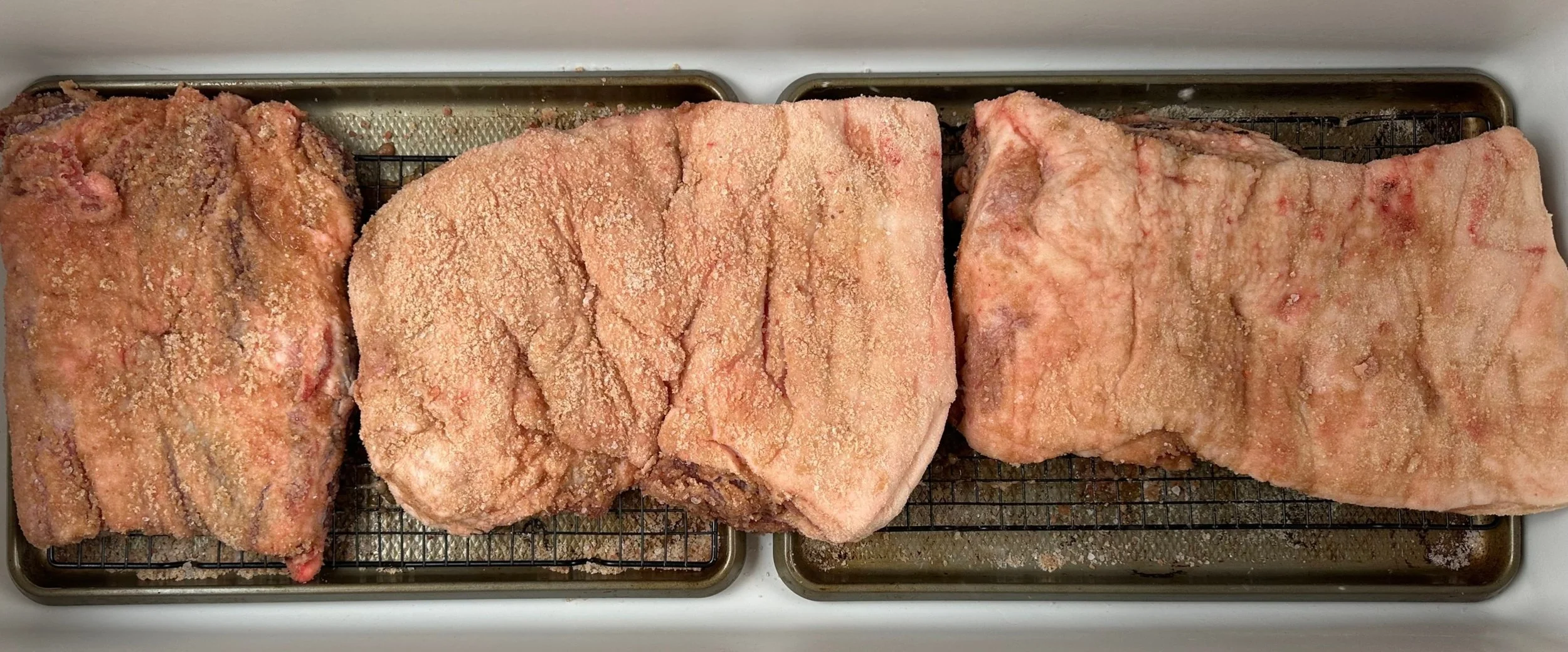Curing Bacon At Home - a How-To and Why Guide
Nothing beats the rich, smoky flavor of homemade bacon, especially when it’s made from high-quality, pasture-raised pork. Curing bacon at home is a simple and rewarding process that allows you to control the ingredients, avoid unnecessary additives, and customize the flavor to your liking. Whether you prefer a classic salt and sugar cure or something more adventurous with spices and herbs, this guide will walk you through the entire process.
What is Bacon Curing?
Curing is the process of preserving and flavoring meat by applying a mixture of salt, sugar, and seasonings. There are two primary methods:
Dry Cure: A mixture of salt, sugar, and optional seasonings is rubbed directly onto the pork belly.
Wet Cure (Brining): The pork belly is submerged in a saltwater solution for curing.
Both methods achieve delicious results, but dry curing is the most traditional and allows for a deeper, more concentrated flavor.
Fun Fact: The “Un-cured” label you see on some storebought bacon is, in fact, still cured. Since it doesn’t contain added nitrates, the USDA requires the “un-cured” term be applied to differentiate from the two products.
Does Curing Bacon Make it Shelf Stable?
The official USDA stance is that a slab of dry-cured bacon is considered a pantry item for up to 3 weeks. Dry-cured bacon that has been sliced is considered safe up to 10 days.
The rub is in the fact that generations of humans regularly turned to curing their meat with salt to make it last for months. Salt pork, however, isn’t the same thing as cured bacon. When PACKED in salt or submerged in a brine, pork that’s kept cool and covered can last for months.
That’s not what we’re doing here, though. So, just take that with a grain of salt. 😏
Essential Ingredients & Gear for Curing Bacon
To cure bacon at home, you’ll need the following:
Pork belly – Fresh, high-quality, pasture-raised pork belly yields the best results.
Salt – The primary curing agent that preserves the meat.
Sugar – Balances the saltiness and enhances the flavor.
Optional seasonings – Black pepper, garlic, smoked paprika, maple syrup, or any other preferred flavors.
Wire rack – I use a cooling rack that I have on hand.
Drip pan – A baking sheet with edges works great for this.
If you want a foolproof cure blend, we offer a homemade bacon cure designed specifically for pasture-raised pork. You’ll find two options, one with cracked pepper and one without.
Step-by-Step Guide to Curing Bacon
Prepare the Pork Belly
Select a fresh pork belly and trim any excessive fat if desired.
Weigh the pork belly to determine the correct amount of cure.
Measure the thickest part to determine how long to cure.
Apply the Cure
Measure out the cure ingredients according to your pork belly’s weight.
Rub the cure evenly over the entire surface, ensuring full coverage.
Refrigerate and Cure
Place the pork belly on a rack and cover. You want to keep it elevated so juices can run out onto a tray.
Meat needs to stay cold during curing, so use a shelf in your refrigerator for this step. Alternatively, wait for cold weather and use a cooler outside!
The curing time depends on thickness—typically one day per ¼ inch of thickness. For example, a 1-inch thick belly will need about 4 days.
Rinse and Dry
Once the curing period is complete, rinse the pork belly under cold water to remove excess cure.
Pat it dry and place it on a rack in the refrigerator uncovered for 12-24 hours. This allows a pellicle (a tacky surface) to form, which helps with smoke absorption if you choose to smoke your bacon.
Smoke or Cook (Optional)
Cold Smoking: Uses low temperatures (below 90°F) for several hours to infuse a smoky flavor without cooking the meat.
Hot Smoking: Cooks the bacon at a higher temperature (200°F) until it reaches an internal temperature of 150°F.
Pastured Pork - Bacon curing in cooler during cold weather
How to Make Shelf-Stable Bacon
As I mentioned before, it is possible to keep your cured bacon in a cool, but not refrigerated, location for some time. For those who want to store bacon in the pantry, proper curing and drying techniques are key:
Proper Dry Curing: Bacon can become shelf-stable if it is salted and cured for the appropriate period, ensuring all moisture is removed. The longer it’s cured, the closer it gets to a true prosciutto.
Thorough Drying: After curing, the bacon should be dried in a low-humidity environment to remove residual moisture. The drier the meat, the longer it will last without refrigeration.
Cold Smoking: Adds an extra layer of preservation by introducing antimicrobial compounds from the smoke.
Storage in a Cool, Dry Place: Once fully cured and dried, bacon can be wrapped in butcher paper and stored in a cool, dry place, similar to how traditional country hams are preserved.
If you're looking for a truly off-grid, shelf-stable bacon, these techniques can help you create a product that lasts without refrigeration while still offering incredible flavor.
Storing and Slicing Your Bacon
If fully cured and dried, store it in a cool, dry place for extended shelf life.
It won’t hurt your bacon to go into the freezer if it makes you feel better!
Slice it to your preferred thickness and cook as needed. It’s easiest to slice when thoroughly cooled.
Why Homemade Cured Bacon is Better
It can be a bit of an adjustment any time you start making things for yourself. Without all the extra ‘stuff’ factories include in the products, homemade goods can seem… different. That being said, I’ve been really, really happy with my home cured bacon!
It doesn’t have the slimy feel that I’ve come to accept as par for the course with store-bought breakfast meat, even when it’s a fatty slice. The texture is firmer and less crumbly, which is a win in my personal opinion.
Better Quality: Made from pasture-raised pork with no unnecessary additives.
Customizable Flavor: Adjust the seasonings and smoking process to your preference.
Healthier Alternative: No artificial preservatives or excessive sodium found in store-bought bacon.
Shelf-Stable Options: With the right curing and drying techniques, bacon can be stored without refrigeration for off-grid living.
Overall, I’m firmly in camp “Homemade is Better” when it comes to bacon!
Final Thoughts
Curing bacon at home is an easy and satisfying way to enjoy high-quality, flavorful meat. If you’re looking for the perfect pasture-raised pork belly or a ready-to-use homemade bacon cure, we’ve got you covered. Try it out and experience the difference of farm-fresh, home-cured bacon!


